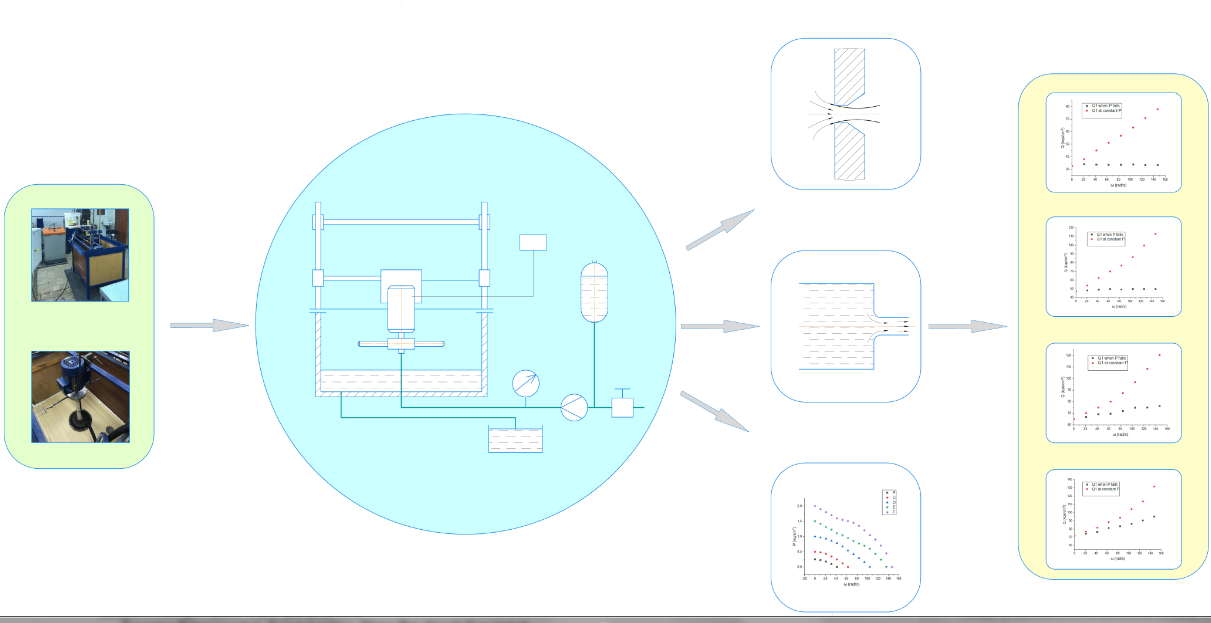Виявлення закономірностей дроселювання рідини інерційної гідродинамічної установки
DOI:
https://doi.org/10.15587/1729-4061.2023.292522Ключові слова:
технологічна вода, тиск, кутова швидкість, дросельні форсунки, потік рідини, гідродинамічний нагрівачАнотація
У статті наведено результати експериментальних досліджень, проведених на спеціально розробленій установці для наддуву різних типів рідин через дросельні отвори. Для визначення оптимального режиму роботи теплової системи використовувалися дросельні форсунки різного діаметру, а саме 1,5 мм, 2 мм, 3 мм.
Однією з головних переваг вихрових обігрівачів є їх висока ефективність теплообміну. Це пов’язано з вихровими рухами та турбулентністю, створеними всередині пристрою, які сприяють більш енергійному перемішуванню рідини, таким чином підвищуючи ефективність теплопередачі.
Однак у вихрових обігрівачів є певні недоліки. Вихрові компоненти можуть зношуватися та вимагати регулярного обслуговування та заміни.
У подальшому в ході експериментальних робіт в лабораторній дослідній установці була розроблена і встановлена альтернативна інерційна гідродинамічна система нагріву теплоносіїв. Основним напрямком дослідження була технічна вода. Результати показали, що статичний попередній тиск, який створюється подачею води з водопроводу в систему, зменшується зі збільшенням кутової швидкості ротора. Експериментальні дослідження показали, що обертання ротора призводить до перерозподілу характеристик потоку в дросельних отворах як для статичного, так і для динамічного інерційного розряду рідини. Враховуючи те, що будь-який статичний стовп рідини призводить до рівня течії через дросельні отвори, встановлено їх потокові статичні параметри.
Крім того, дослідження показали, що зі збільшенням кутової швидкості ротора тиск рідини на дросельних отворах зростає, а частка рідини, що випускається від початкового статичного тиску, зменшується в загальному потоці рідини
Посилання
- Ruonan, W., Bin, L., Haodong, L. (2021). Experimental results and analysis of throttling refrigeration with ternary mixed refrigerant. E3S Web of Conferences, 236, 01008. doi: https://doi.org/10.1051/e3sconf/202123601008
- Guo, G., Lu, K., Xu, S., Yuan, J., Bai, T., Yang, K., He, Z. (2023). Effects of in-nozzle liquid fuel vortex cavitation on characteristics of flow and spray: Numerical research. International Communications in Heat and Mass Transfer, 148, 107040. doi: https://doi.org/10.1016/j.icheatmasstransfer.2023.107040
- Alia, M. A. K. (2010). Hydraulic Domestic Heating by Throttling. Engineering, 02 (06), 461–465. doi: https://doi.org/10.4236/eng.2010.26060
- Polášek, T., Hružík, L., Bureček, A., Ledvoň, M. (2022). Experimental Analysis of Flow Through Throttle Valve During Gaseous Cavitation. MATEC Web of Conferences, 369, 02008. doi: https://doi.org/10.1051/matecconf/202236902008
- Vasina, M., Hruzik, L., Burecek, A. (2018). Energy and Dynamic Properties of Hydraulic Systems. Tehnicki Vjesnik - Technical Gazette, 25, 382–390. doi: https://doi.org/10.17559/tv-20131209081056
- Mokhammad, A. A., Khorosh, I. A., Titov, M. A., Kulikova, N. P. (2015). The calculation of the throttle device heating working fluid of hydraulic drive having a temperature dependence. Vestn. Kras GAU, 12, 38–44.
- Shumilov, I. (2016). Fluid Temperature of Aero Hydraulic Systems. Machines and Plants: Design and Exploiting, 16 (02). doi: https://doi.org/10.7463/aplts.0216.0837432
- Marinin, M. G., Mosalev, S. M., Naumov, V. I., Sysa, V. P. (2007). Pat. No. RU2357161C1. Throttle Type Heat Generator. declareted: 06.11.2007; published: 27.05.2009.
- Saleh, H., Hashim, I. (2013). Unsteady heat transfer in an enclosure with a time-periodic rotating cylinder. Heat Transfer Research, 44 (2), 145–161. doi: https://doi.org/10.1615/heattransres.2012005450
- Alpeissov, Y., Iskakov, R., Issenov, S., Ukenova, А. (2022). Obtaining a formula describing the interaction of fine particles with an expanding gas flow in a fluid layer. Eastern-European Journal of Enterprise Technologies, 2 (1 (116)), 87–97. doi: https://doi.org/10.15587/1729-4061.2022.255258
- Maiorova, K., Vorobiov, I., Andrieiev, O., Lupkin, B., Sikulskiy, V. (2022). Forming the geometric accuracy and roughness of holes when drilling aircraft structures made from polymeric composite materials. Eastern-European Journal of Enterprise Technologies, 2 (1 (116)), 71–80. doi: https://doi.org/10.15587/1729-4061.2022.254555
- Aghakashi, V., Saidi, M. H. (2018). Turbulent decaying swirling flow in a pipe. Heat Transfer Research, 49 (16), 1559–1585. doi: https://doi.org/10.1615/heattransres.2018021519
- Oshanov, Y., Ovcharov, M., Nussupbekov, B., Stoev, M. (2020). The influence of the main properties of the liquid on the temperature indicators of the inertial heat generator. Bulgarian Chemical Communications, 52, 188–191. Available at: http://www.bcc.bas.bg/BCC_Volumes/Volume_52_Special_A_2020/BCC-52-A.pdf
- Bashta, T. M. (1972). Engineering Hydraulics. Moscow: Mashinostroenie.
- Nussupbekov, B., Oshanov, Y., Ovcharov, M., Mussenova, E., Ospanova, D., Bolatbekova, M. (2022). Development and creation of a hydrodynamic liquid heating unit. Eastern-European Journal of Enterprise Technologies, 5 (8 (119)), 62–69. doi: https://doi.org/10.15587/1729-4061.2022.264227
- Oshanov, Y. Z., Ovcharov, M. S., Nusupbekov, B. R. (2022). Influence of inertial forces on the flow rate velocity of fluid outflow through the throttle bores of the rotor. Heat Transfer Research, 53 (14), 1–8. doi: https://doi.org/10.1615/heattransres.2022038753

##submission.downloads##
Опубліковано
Як цитувати
Номер
Розділ
Ліцензія
Авторське право (c) 2023 Bekbolat Nussupbekov, Yerlan Oshanov, Michael Ovcharov, Bayan Kutum, Мoldir Duisenbayeva, Aitkul Kongyrbayeva

Ця робота ліцензується відповідно до Creative Commons Attribution 4.0 International License.
Закріплення та умови передачі авторських прав (ідентифікація авторства) здійснюється у Ліцензійному договорі. Зокрема, автори залишають за собою право на авторство свого рукопису та передають журналу право першої публікації цієї роботи на умовах ліцензії Creative Commons CC BY. При цьому вони мають право укладати самостійно додаткові угоди, що стосуються неексклюзивного поширення роботи у тому вигляді, в якому вона була опублікована цим журналом, але за умови збереження посилання на першу публікацію статті в цьому журналі.
Ліцензійний договір – це документ, в якому автор гарантує, що володіє усіма авторськими правами на твір (рукопис, статтю, тощо).
Автори, підписуючи Ліцензійний договір з ПП «ТЕХНОЛОГІЧНИЙ ЦЕНТР», мають усі права на подальше використання свого твору за умови посилання на наше видання, в якому твір опублікований. Відповідно до умов Ліцензійного договору, Видавець ПП «ТЕХНОЛОГІЧНИЙ ЦЕНТР» не забирає ваші авторські права та отримує від авторів дозвіл на використання та розповсюдження публікації через світові наукові ресурси (власні електронні ресурси, наукометричні бази даних, репозитарії, бібліотеки тощо).
За відсутності підписаного Ліцензійного договору або за відсутністю вказаних в цьому договорі ідентифікаторів, що дають змогу ідентифікувати особу автора, редакція не має права працювати з рукописом.
Важливо пам’ятати, що існує і інший тип угоди між авторами та видавцями – коли авторські права передаються від авторів до видавця. В такому разі автори втрачають права власності на свій твір та не можуть його використовувати в будь-який спосіб.










